
“Hatty told Matty: “Let’s don’t take no chance.
Let’s not be *L-seven*, come and learn to dance.”
Wooly bully, wooly bully.
Wooly bully, wooly bully, wooly bully.”1
Just a little something I do to diminish reader expectations and to remind myself of how I earned those early departures from numerous institutions of higher learning. I believe some creative writing courses might have benefited all of us.
I’ve been photographing, disassembling, reassembling, studying, and shooting the Winchester Model 70 Alaskan since the onset of Part 1. Unlike what has been the case with most firearms I process, it remains a source of shooting enjoyment. The Winchester has a natural feel of a quality big game hunting rifle; powerful, intuitive shooting and reliable cycling. The big Winchester locks up behind a cartridge like a bank vault door. The heft and geometry of the Alaskan work so well that recoil would not be considered excessive for a grown man or women. If a person makes a wincing face and feigns shoulder pain at the mention of the 338 Winchester Magnum Model 70 Alaskan, they’ve never shot this rifle.
A brief Winchester Magnum retrospective…
Left to right, the 30-06 Springfield (1906), the 300 Winchester Magnum (1963) and the 338 Winchester Magnum (1958). The 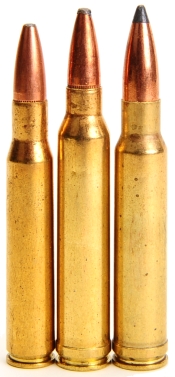 338 Winchester Magnum was derived from the 458 Winchester Magnum of 1956, sharing its 1958 introduction spotlight with a second derivative cartridge, the flat shooting 264 Winchester Magnum.
338 Winchester Magnum was derived from the 458 Winchester Magnum of 1956, sharing its 1958 introduction spotlight with a second derivative cartridge, the flat shooting 264 Winchester Magnum.
I assume the bump in case capacity for the 300 Winchester Magnum was brought about by a need for Winchester to differentiate its new magnum from the then still popular 300 H&H. The 338 Winchester Magnum had no similar factory cartridge competition when released. For that matter, neither did the 458 Winchester or 264 Winchester Magnums.
|
Cartridge |
Capacity Grains H2O |
| 264 Winchester Magnum | 81 |
| 300 Winchester Magnum | 88 |
| 338 Winchester Magnum | 86 |
| 458 Winchester Magnum | 89 |
| 300 H&H Magnum | 83 |
| 375 H&H Magnum | 93 |
Winchester’s blown out and sharpened shoulder trio’s claim to fame has been performance on par with full length cartridges based on the 375 H&H Magnum, but with the ability to function in a 30-06 Springfield length action. The fact that these Winchester Magnum rounds have been routinely chambered in a wide variety of reasonably priced firearms has not hurt their popularity.
Bullets… points, trains and projectiles
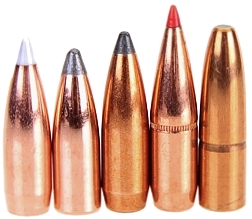
We had a good number of 0.338″ bullets on hand, however, the above 250 grain types are generally reserved for the oversize 338 caliber rounds like the 338-378 Weatherby, or 338 Remington Ultra Mag. For the 338 Winchester Magnum, a decision was made to work between 180 and 250 grain bullet weights as a best balance of trajectory and power.
| Bullet | Type | Weight | Length |
| Nosler AccuBond | Poly Tip | 180 | 1.235 |
| Speer Hot-Cor | SPFB | 200 | 1.145 |
| Sierra | SPBT | 215 | 1.260 |
| Hornady SST | Poly Tip | 225 | 1.440 |
| Woodleigh | PP | 250 | 1.290 |
The 180 grain Nosler is a heck of a bullet for lighter game that can be loaded up to be essentially point blank out to 300 yards, or loaded down to 3,000 fps with reduced recoil. The Speer, Sierra and Hornady bullets are heavy for deer, but just about right for elk and moose. The Woodleigh is a good choice for tougher and more dangerous game.
By Hornady’s description, the 338 SST 225 grain is streamlined for ultra-flat trajectories. It has a ballistic coefficient of 0.505 and a sectional density of 0.281. The jacket carries striations to help facilitate uniform and consistent expansion within a broad velocity range. The Hornady Secant Ogive design forms a steep taper and the SST has a boat tail, which leaves the bullet with a long shank, but modest bearing surface, and a long projecting nose. Big picture illustration to follow…
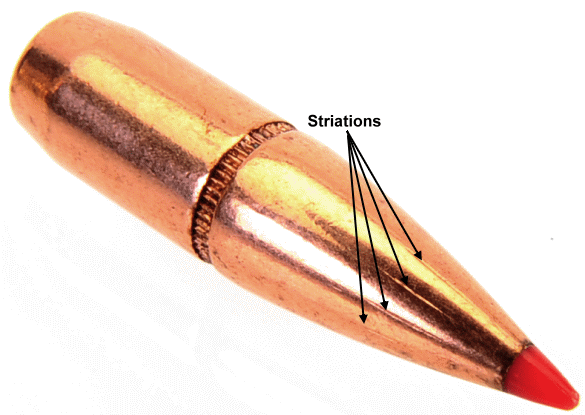
To match case mouth with the SST’s cannelure placement requires deep seating. As a result, the 225 grain Hornady bullet sets the 338 Winchester Magnum’s case capacity at 72.4, while the shorter but heavier 250 grain Woodleigh results in 75.3 grains of net capacity. The 1.500″ Barnes TTSX and 1.630″ Berger Match Elite Hunter were set aside because of their exception length and negative impact on powder capacity.
 |
Warning: Bullet selections are specific, and loads are not valid with substitutions of different bullets of the same weight. Variations in bullet length will alter net case capacity, pressure and velocity. Primer selection is specific and primer types are not interchangeable. These are maximum loads in my firearms and may easily be excessive in others. All loads should be reduced by 5%, and developed following safe handloading practices as represented in established reloading manuals produced by component manufacturers. Presentation of these loads does not constitute a solicitation for their use, nor a recommendation.
|
||||||||||||||||||||||||||||||||||||||||||||||||||||||||||||||||||||||||||||||||||||||||||||||||||||||||||||||||||||||||||||||||||||||||||||
|
|||||||||||||||||||||||||||||||||||||||||||||||||||||||||||||||||||||||||||||||||||||||||||||||||||||||||||||||||||||||||||||||||||||||||||||
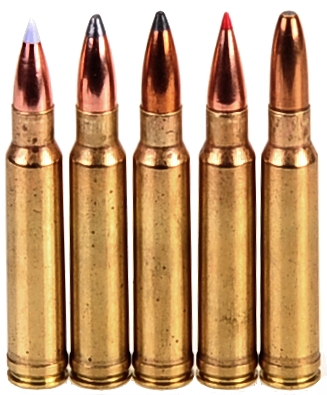
Loads were assembled utilizing once fired Winchester brass. Most reloading manuals indicate a good number of compressed loads for the 338 Winchester Magnum, however, none of the loads indicated were compressed. Brass wet checked 88.2 grains, or 2.2 grains above nominal spec, which might be the reason. All cases where full length resized, length trimmed and deburred prior to reloading. For the sake of curiosity, I loaded one case three times, annealed its neck with the “cherry red brass – burnt finger method” and reloaded the same case three more times before stopping out of boredom. A good result for not so inexpensive belted magnum brass.
And back to the Winchester Model 70 Alaskan
I can’t think of a rifle I’ve handled in recent times that was less phased by being worked hard. Usually, a rifle will start to dirty up and shoot a little looser after running through a few boxes of ammo from the bench. This one didn’t seem to even accumulate powder residue. The barrel barely got warm from the shooting routine. Shooting without a rest, the recoil pad felt soft, probably because it is a little wider than the average light weight, light caliber sporter. The Model 70 is also well balanced so it didn’t feel heavy on my extended arm when shooting from a standing position, just balanced weight.
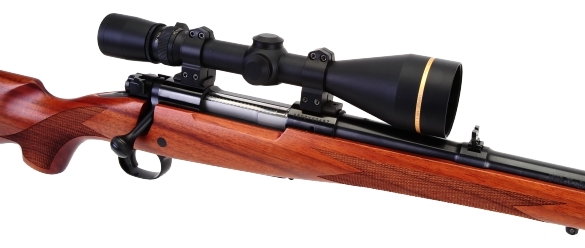
I couldn’t get over how smoothly the Alaskan fed ammo from the magazine or how easy it was to top load without having to fiddle to get rounds seated securely in the magazine. The comb height works; very natural scope – eye alignment. No, this isn’t a varmint rifle and I don’t think it would be appropriate as a rifle dedicated to hunting white tail deer. However, if hunting includes elk, moose or bear, this could be an excellent all purpose firearm. For further information on price and availability, check out the Winchester site.
Winchester’s Model 70 Alaskan Part 1
Winchester’s Model 70 Alaskan Part 2

Email Notification